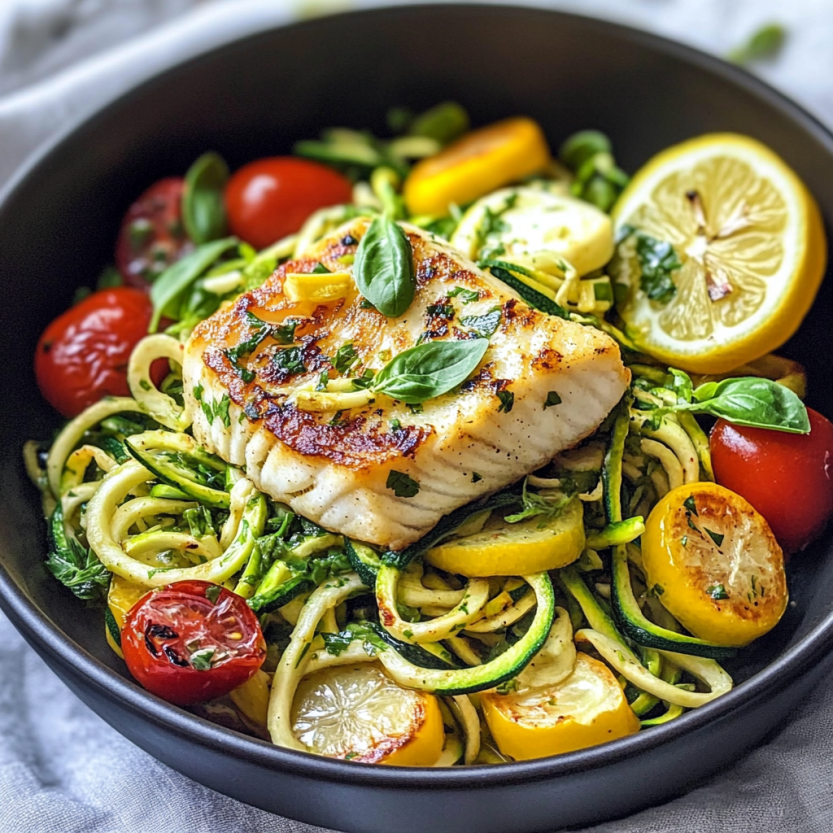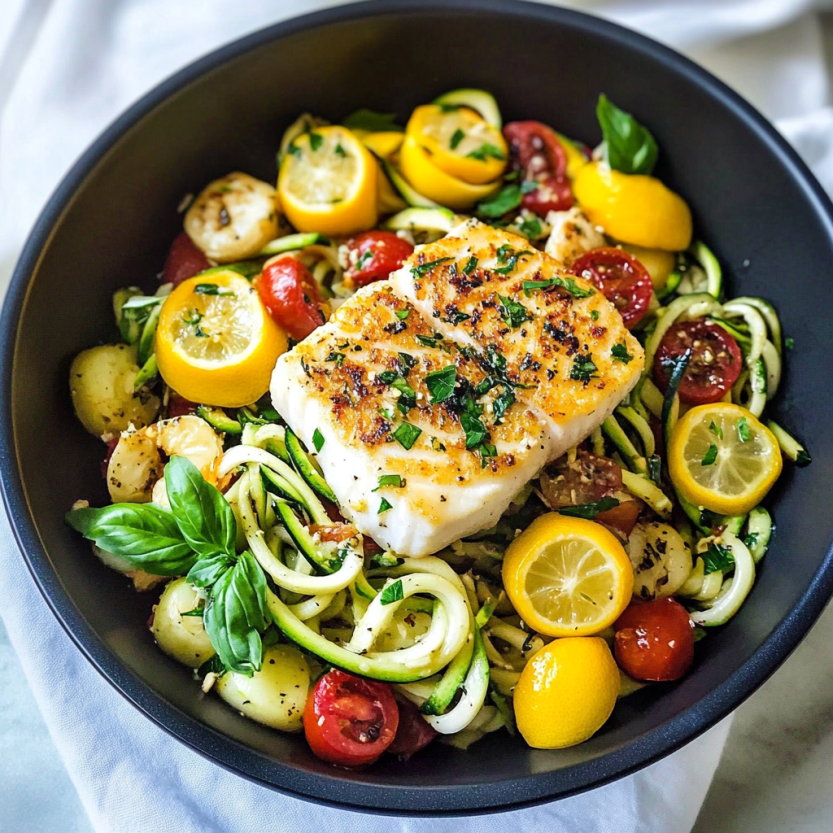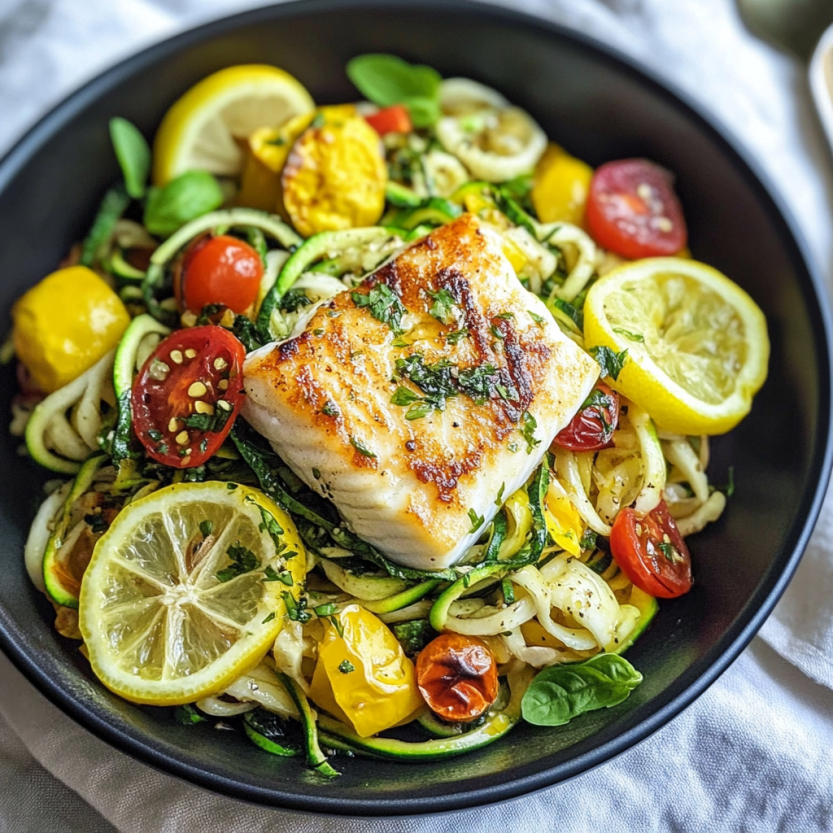 Save
Save
This lemony zucchini noodle dish with halibut has become my go-to recipe whenever I want something light yet satisfying. The delicate flavors of the fish paired with zesty zucchini create a perfect balance that feels both indulgent and wholesome.
I first made this dish when trying to impress my health-conscious friend who was visiting, and now it's become my personal favorite for those evenings when I want something light but still packed with flavor.
Ingredients
- Halibut fillets: fresh is best but frozen works too as long as it's properly thawed
- Garlic cloves: they infuse both the fish and noodles with aromatic flavor
- Olive oil: use a good quality extra virgin for the best flavor profile
- Zucchini noodles: look for firm zucchini with unblemished skin for the best texture
- Shallot: provides a milder sweeter flavor than regular onions
- Lemon zest and juice: brightens the entire dish and cuts through the richness of the fish
- Fresh parsley: adds color and a clean herbaceous note that complements the seafood
- Cherry tomatoes: choose the sweetest varieties you can find for bursts of flavor
Step-by-Step Instructions
- Preheat and Prepare:
- Set your oven to 375°F and gather all ingredients. This step ensures everything cooks properly and creates the perfect environment for finishing the halibut.
- Season the Fish:
- Pat the halibut completely dry with paper towels and season generously with salt and pepper. Proper drying is crucial for achieving that beautiful golden sear on the fish.
- Infuse the Oil:
- Heat olive oil in a skillet and add a smashed garlic clove. Allow the garlic to release its flavor into the oil until fragrant but not burned. This creates an aromatic base that will flavor the fish.
- Sear the Halibut:
- Place the seasoned halibut in the hot garlic oil and let it sear undisturbed until golden. The key here is patience. Allow the fish to form a crust which naturally releases from the pan when ready. Flip and sear the second side until equally golden.
- Finish in Oven:
- Transfer the seared halibut to the preheated oven to finish cooking gently. This method ensures a perfectly cooked interior while maintaining that crispy exterior. The halibut is done when it flakes easily with a fork.
- Prepare the Zucchini Base:
- In a separate large skillet heat olive oil and sauté shallots and chopped garlic until translucent and aromatic. The sweetness from properly sautéed shallots creates depth in the final dish.
- Cook the Zoodles:
- Add the zucchini noodles to the shallot mixture and sauté until they just begin to soften. Be careful not to overcook as they can quickly become mushy. They should retain a slight bite for the best texture.
- Add Finishing Touches:
- Toss the zucchini noodles with fresh lemon zest parsley and a squeeze of lemon juice. Taste and adjust the seasoning with salt and more lemon if needed. The acidity brightens the entire dish.
- Plate and Serve:
- Divide the lemony zucchini noodles between plates and top with the perfectly cooked halibut. Garnish with halved cherry tomatoes and optional chili flakes or shaved pecorino cheese for an extra flavor dimension.
 Save
Save
The lemon zest is actually my secret weapon in this dish. I learned from my grandmother that zest contains the oils from the lemon skin which carry far more aromatic punch than just the juice alone. Whenever I make this for friends they always ask what makes it taste so bright and vibrant.
Making Perfect Zucchini Noodles
The key to great zucchini noodles lies in how you prepare and cook them. Use a spiralizer for the best noodle shape and texture. If you dont have one a vegetable peeler can create wider ribbons that work just as well. The most common mistake when cooking zucchini noodles is overdoing it. They release a lot of moisture when cooked so keeping the cooking time brief preserves their texture. I recommend salting them lightly before cooking and patting them dry to draw out excess moisture. This prevents your finished dish from becoming watery.
Protein Variations
This recipe welcomes substitutions based on what you have available or prefer. Salmon works beautifully and adds more richness while remaining tender and flaky. Sea bass or cod make excellent white fish alternatives with their mild flavors. For a shellfish version scallops sear quickly and have a natural sweetness that pairs wonderfully with the lemony zucchini. Plant-based eaters can substitute firm tofu sliced into steaks and seared the same way as the fish. The key with any protein is to not overcook it before adding to the zucchini base.
 Save
Save
Serving Suggestions
For a complete meal experience consider what accompanies this dish. A simple side salad with a light vinaigrette complements without overwhelming. If you're serving guests a crusty piece of sourdough bread on the side helps soak up the flavorful juices. For wine pairing choose something crisp and citrusy like a Sauvignon Blanc or unoaked Chardonnay that echoes the lemon notes in the dish. This recipe shines as the star of a light summer dinner party or an elegant lunch that impresses without hours of preparation.
Storage Tips
While this dish is best enjoyed immediately after preparation leftovers can be stored for a quick lunch the next day. Keep the fish and zucchini noodles separate in airtight containers in the refrigerator for up to two days. Reheat the zucchini noodles gently in a skillet with a splash of water. For the fish reheat at a low temperature in the oven wrapped in foil to preserve moisture. Microwaving is not recommended as it can make the fish rubbery and the zucchini soggy.
Recipe Questions
- → What can I substitute for halibut?
You can substitute salmon, sea bass, cod, scallops or shrimp for the halibut. For a vegetarian version, firm tofu works well - just be sure to press it dry before cooking.
- → How do I make zucchini noodles if I don't have a spiralizer?
If you don't have a spiralizer, you can use a vegetable peeler to create wide ribbons, a julienne peeler for thinner strands, or simply cut the zucchini into thin strips with a sharp knife. Many grocery stores also sell pre-spiralized zucchini in the produce section.
- → Why does my fish stick to the pan when cooking?
Fish typically sticks when you try to flip it too soon. Allow the fish to sear undisturbed until it develops a golden crust - it will naturally release from the pan when ready. Also ensure your pan is properly heated and has enough oil before adding the fish.
- → How can I tell when the halibut is fully cooked?
Properly cooked halibut should be opaque and flake easily with a fork. For a 1-inch thick piece, this usually takes 3-6 minutes in a 375°F oven after searing. The internal temperature should reach 130-135°F for medium doneness.
- → Is this dish suitable for meal prep?
This dish is best enjoyed fresh, but you can prep components ahead of time. Pre-spiralize zucchini and store in paper towels to absorb moisture. Chop herbs and garlic in advance. For leftovers, store fish and zucchini separately and reheat gently to prevent overcooking the fish.
- → What side dishes pair well with this?
Since this is already a complete meal, simple sides work best. Try crusty bread for those not watching carbs, a light green salad, or roasted asparagus. A chilled glass of Sauvignon Blanc or Pinot Grigio complements the lemony flavors beautifully.